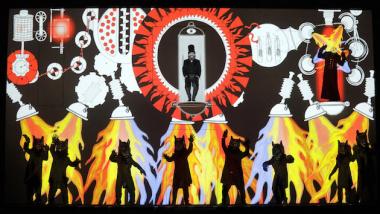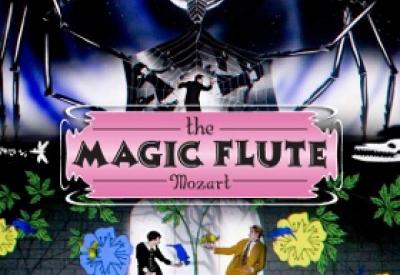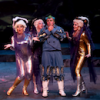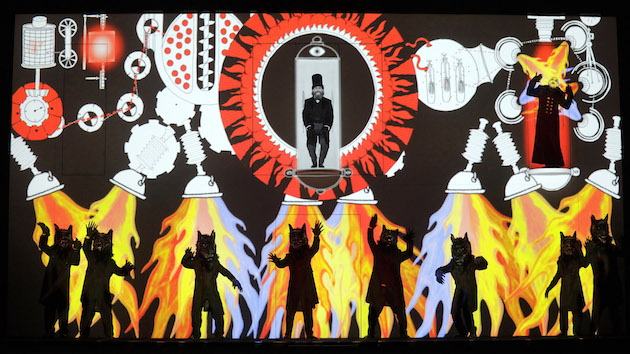
The world, and particularly the world of Los Angeles, has changed a great deal since 2013, when LA Opera first presented Barrie Kosky’s silent film homage production of Mozart’s The Magic Flute. Then fresh from Kosky’s Komische Oper Berlin, the eye-popping production, with its dazzling interactive animation by Suzanne Andrade and Paul Baritt, burst on the scene to rave reviews. It was equally well received when it was revived here, in 2016.
The next year, however, America experienced a tectonic shift in social consciousness regarding what constitutes the proper treatment and depiction of women. The #MeToo movement emerged and focused a spotlight on acts of sexual misconduct and harassment that had existed in the shadows for years. A candidate for president claimed that his celebrity status gave him carte blanche to treat women in any degrading way he chose. Then the controversy struck LA Opera to its core, when its artistic director, Plácido Domingo, was accused of sexual harassment, bringing his leadership of the organization to an ignominious end.
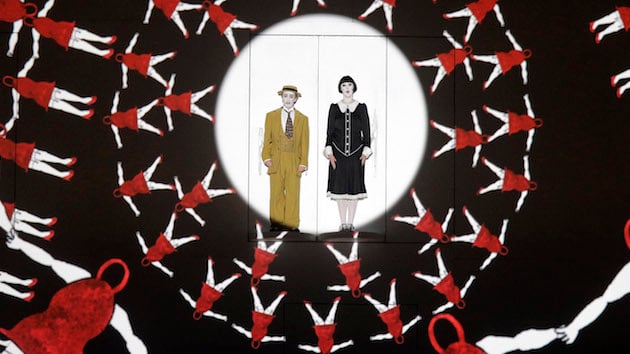
It is through this shifting lens of perception that we now need to reevaluate Kosky’s Magic Flute (the most successful staging in the company’s history) as it returns to the stage of the Dorothy Chandler Pavilion for the third time. And while the production — sung by a fine young cast conducted by James Conlon — unquestionably retains all of its Mozartean splendor, our perception of Kosky’s provocative production has changed with the times.
The Magic Flute has always been one of the most glaring examples of opera’s routine misogyny, but of course Mozart’s incredible music makes you want to ignore the directly stated themes of the libretto. Opera producers have helped that along by emphasizing the fantasy and fairytale setting and playing up the comedy and silliness at the expense of dramatic motivation and character. Only Pamina, with her tragic aria “Ach, ich fuhls” ever escapes this cartoon reality, in most productions. The modern Magic Flute is a show for designers, as this one is. The most impactful thing about Kosky’s production is its clever, interactive visual scheme, created by Andrade and Barritt.
When we first saw the show, we enjoyed it unthinkingly: we were awestruck and beguiled. In the current context, the issues that the designers want us to confront come uncomfortably to the fore. Its glossy surface was never intended to conceal, but to provoke us into recognizing, even if subconsciously, the misogynistic imagery that casts women as either devouring bitches, zaftig sexual objects, or mindless chatterboxes incapable of controlling their lives without proper leadership from their stronger, more “rational,” male overseers.
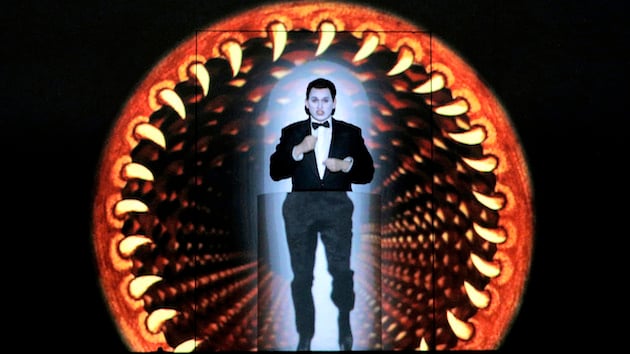
Using visual cues from the “golden age” of silent movies, the show transforms Tamino (Bogdan Volkov) into a tuxedo-clad Harold Lloyd; Pamina (Zuzana Marková) into a winsome Louise Brooks; Papageno (Theo Hoffman) into an ever-flustered Buster Keaton, and the Moor, Monostatos (Frederick Ballentine) into silent cinema’s first bloodsucker, Nosferatu.
And then there is the opera’s fraternal order (the Masons) — an all-male, white power-structure led by Sarastro (Ildebrando D’Arcangelo) represented as the identically bearded and top-hated fathers of the Industrial Revolution. The irony is that these God-given guardians of the “enlightenment’ are the very titans of industry who will (offstage) ultimately plunge us toward the crisis of global climate change.
Andrade and Barritt do their best to avoid letting audiences buy into the fantasy without looking at its darker side. women, led by the Queen of the Night (So Young Park, who is depicted as a vicious, manipulative giant spider whose multiple legs bestride the stage like a devouring colossus— a Jungian nightmare of the all-devouring female), are the enemies in this production and we don’t get to indulge in prettified images of them.
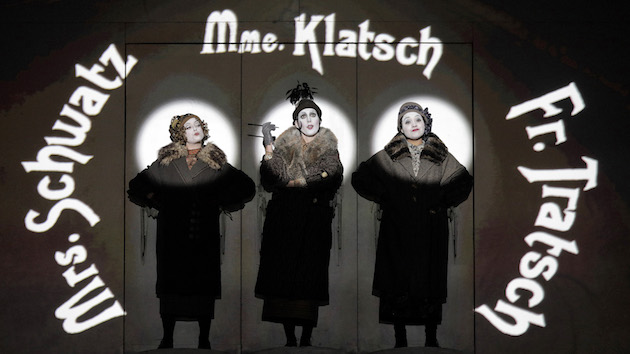
Her three, marvelously sung henchwomen (“Ladies” Erica Petrocelli, Vivien Shotwell, and Taylor Raven) are a trio of European sophisticates (or perhaps prostitutes) who would kill to get their hands on “that beautiful, innocent young boy,” Tamino. When Papagena (Sarah Vautour) finally arrives to fulfill the dreams of Papageno, she is depicted as a gaudy, lower-class, dancehall trollop, perfectly suited to become her lower-class husband’s mate.
The “magic flute” itself is transformed into a version of Tinker Bell, who flits about dispensing melodies to soothe the savage breast, while Papageno’s magic bells emerge from a Pandora’s box, as a phalanx of dancing chorus girls.
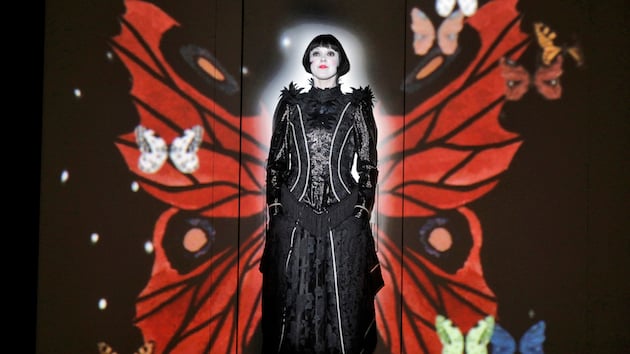
Poor, helpless Pamina is the exception, as usual, beautifully and plaintively sung by Marková. Emotionally conflicted, she finds herself the victim in a violent custody battle, torn between a terrifying mother and the pompous, holier-than-thou father who has kidnapped her. She is also trapped in a male-dominated world that is determined to keep her in her place as a proper docile companion. In one of the production’s most telling scenes, the followers of Isis and Osiris remove her childhood dress of white and transform her into her into a rigidly corseted Victorian woman dressed from head to toe in mourning black.
Through the ploy of the silent movies, Kosky does away with the dialogue by Emanuel Schikaneder. In its place, lines from the libretto are projected as silent movie intertitles, condensing the action and accompanied by a pastiche of Mozartean phrases performed by Peter Walsh at the fortepiano. But Kosky resists bowdlerizing the story: Sexist sentiments abound, which prompted more than a few uncomfortable groans in the audience. The discomfort was the point. And it’s interesting that only now is that obvious.
The musical aspects of the performance were all that could be wished for.
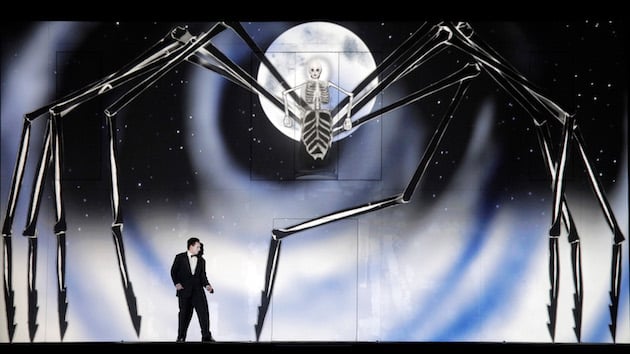
Volkov possesses a bright lyric tenor ideally suited to the role of Tamino, as is the resonance and comic gifts of Hoffman as Papageno. So Young Park was an impressive Queen of the Night until her high notes turned screechy, while D’Arcangelo proved less than resounding at the bottom end of the scale as Sarastro. Ballentine made a wonderfully menacing Monostatos
James Conlon conducted a great orchestra, with a special nod Heather Clark, the LA Opera orchestra’s own magic flute.

